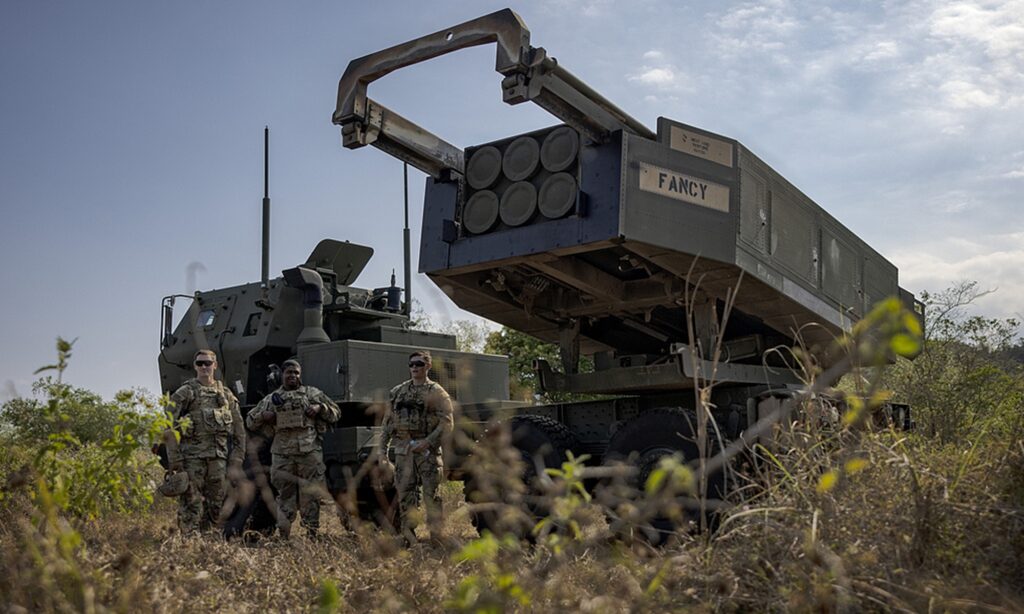The Chinese foreign ministry on Monday expressed opposition to relevant countries using the Taiwan question as an excuse to strengthen military deployment and heighten tensions, as the US is reportedly going to deploy missile units on islands of Japan and the Philippines as part of “contingency plans for a possible future emergency involving Taiwan.”
When asked to comment on a report by Japanese media on US plan to work with Japan on contingency plans for a possible future emergency involving Taiwan, including deploying missile units on islands of Japan and the Philippines, Mao Ning, a spokesperson of the Ministry of Foreign Affairs, said Taiwan is an inalienable part of China’s territory, and the Taiwan question is China’s internal affair.
“The key to upholding cross-Straits peace and stability is to remain committed to the one-China principle. China firmly opposes relevant countries using the Taiwan question as an excuse to strengthen military deployment in the region, heighten tensions and confrontation, and disturb regional peace and stability.”
According to Kyodo News on Monday, quoting sources familiar with Japan-US relations, the US military will set up “temporary bases along Japan’s southwestern Nansei island chain and the Philippines” to deploy missile units, and the deployment will be “incorporated in the first joint operation plan for the US and Japan” to cope with a “contingency” involving the Chinese mainland and the island of Taiwan to be formulated in December.
Chinese observers said the deployment matter seems familiar – Japanese media disclose “explosive news” against China but neither Japanese nor US officials respond, which could be their “double act” to test China’s reaction while exaggerating regional tensions.
Li Fei, a professor at the Taiwan Research Center at Xiamen University, told the Global Times that the US and its allies like Japan have always tried to test China’s bottom-line on the Taiwan question by gradually strengthening their military deployments or military activities in the region, to encourage Taiwan separatists and hype tensions, and also set obstacles for China’s reunification efforts. “This is just an old trick with no surprise, and China is prepared,” Li said.
Due to the provocations by the Democratic Progressive Party (DPP) authorities and the US in recent years, the Chinese military forces have conducted a series of military drills in recent years, and “the more they provoke, the more opportunities will be provided for the Chinese mainland to strengthen its military preparations to solve the problem,” Li noted.
The US Marine Littoral Regiment, which possesses a multiple-launch High Mobility Artillery Rocket System (HIMARS), will be deployed along the island chain stretching from the Japanese prefectures of Kagoshima and Okinawa toward the island of Taiwan, according to the sources, Kyodo News reported.
The Japan Self-Defense Forces is expected to mainly engage in logistical support for the US marine unit, including supplying fuel and ammunition. The US Army will deploy the Multi-Domain Task Force’s (MDTF) long-range fire units in the Philippines. The MDTF is designed to operate in a multi-domain environment, including air, land, water, space, cyber, and information, according to Kyodo News.
Known in short as HIMARS, the US-made High Mobility Artillery Rocket System has been a focus in media reports due to its deployment in the Russia-Ukraine conflict. It is characterized by its high mobility, high accuracy and long range, but is having lackluster performances recently because the Russians have found counters to it, Fu Qianshao, a Chinese military expert, told the Global Times on Monday.
One counter is drone reconnaissance, and once the HIMARS is spotted, the drone will summon fire strikes to destroy the HIMARS before it relocates, Fu said, noting that another counter is electronic interference. The Washington Post reported in May that many US-made satellite-guided munitions including HIMARS failed to withstand Russian jamming technology.
Fu further noted that if the HIMARS is to be deployed on Japanese islands, it will not have enough space like on the Russian-Ukraine battlefield.
Islands have complicated terrains and elevations, and it will not be as easy to become mobile. Another point is that islands have limited defense depths, which means that no matter how the HIMARS maneuvers, it cannot leave the area entirely, so once it is locked on by drones, it will very likely get attacked, Fu said. “On the other hand, the Chinese People’s Liberation Army (PLA) forces can launch attacks from the vast depths on the mainland.”
Also, the HIMARS is less capable than its Chinese counterparts, Fu noted. Even if the HIMARS to be deployed on the Japanese islands is equipped with the ATACMS tactical missile, the PLA’s long-range rocket systems can still outrange it, Fu said.
According to the Kyodo report, the US Army will also deploy the Multi-Domain Task Force’s long-range fire units in the Philippines.
Fu said the US’ military deployment plan aims to blockade key channels for PLA vessels to enter the West Pacific, such as the Miyako Strait and the Bashi Channel. If these countries dare to launch attacks with weapons like HIMARS, the PLA will launch counterattacks, and their chances of survival will be very low.
The external forces must understand that interfering in the Taiwan question is a dead end, and their military deployment plan cannot change China’s capability and determination over the Taiwan question, Fu said.
